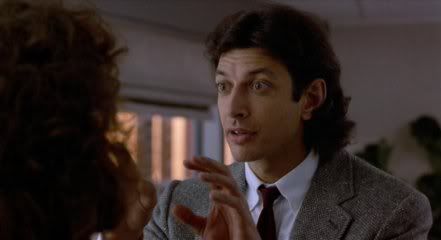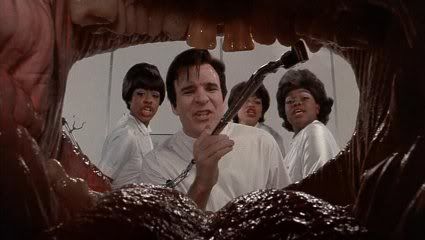
"Is this a romance we're having? Is that what it is?" - SETH BRUNDLE, a brilliant but socially awkward scientist who's working on something that will change the world and human life as we know it
Mainstream horror cinema was in a bad way in the mid-'80s. Following the boffo box office of Halloween in 1978 and especially Friday the 13th in 1980, theaters (and video store shelves) were soon glutted with imitation slasher flicks about masked maniacs stalking frequently unclothed young women and hacking them to pieces with assorted kitchen utensils and gardening tools. This is, of course, not to forget the innumerable sequels these films engendered, few of which existed for anything other than mercenary reasons. This trend was also occasioned by a veritable race to the bottom with makeup artists of all skill levels competing to see who could devise the most nauseating gore effects which, more often than not, had to get cut back significantly in order for the films in which they appeared to get the all-important "R" rating. (This was well before the vogue for "unrated" video releases, so if something didn't cut the muster with the MPAA it generally wouldn't get seen outside of the grindhouses and urban markets.)
This is, of course, not to suggest that all was doom and gloom. Discriminating horror fans who dug a little deeper were rewarded with the occasional gem, and there were certain directors who could be counted on to deliver the genre goods while still treating their subjects with a certain amount of intelligence. One such director was Canadian auteur David Cronenberg, who had started making a name for himself a decade earlier with a low-budget film called Shivers, which was renamed They Came from Within when it was released in the States and caused a stir among horror aficionados. Over the next few years he followed it with Rabid (the legitimate acting debut of Behind the Green Door star Marilyn Chambers), The Brood (which was identified as a cult movie by no less an authority than Danny Peary) and Scanners (which was his commercial breakthrough in the American market). Being number one at the box office for one weekend (as Scanners was) brought Cronenberg to the attention of Hollywood and thus began the process of introducing his work to a wider audience. Of course, a major part of that would involve downplaying the extreme imagery (like the phallic organ in Chambers's armpit in Rabid or the exploding head in Scanners) that punctuated Cronenberg's films. What appealed to the Fangoria crowd wouldn't necessarily fly with general audiences -- not without some help.
Continue reading The Fly, reviewed by Craig J. Clark and Joe Blevins.

